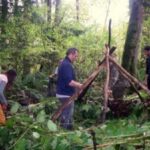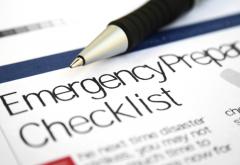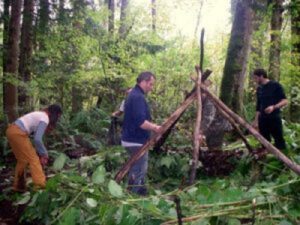
Many prepper’s plans for surviving a state of absolute anarchy are often limited to specific readiness details, such as selecting firearms, growing and preserving food, keeping a bugout bag readily available, building improvised shelters, etc. Knowledge, skills, and abilities in numerous such details are essential to survival in a lawless world. Likewise, standing back from the specifics to consider overview planning concepts gives preppers insights into the larger picture that increases their chances to survive the die-off and prosper long term.
Here are 3 general planning concepts you can apply to your specific preparation planning and implementation actions. These are the down and dirty basics. Research them to gain more comprehensive expertise.
General Planning Concept 1: Problem-Solving Steps.

These problem-solving steps are a summation of more a complex process often used by large corporations to address major problems, but present the sufficient guidance necessary to address TEOTWAWKI basic survival planning problems.
Step 1. Define the problem: This is a no-brainer. We have already defined the problem. Based on current national and international economic, political, and societal conditions, it appears very likely that a state of absolute anarchy will occur within the next generation, if not sooner. The potential for a coronal mass ejection, super volcano eruption(s), or asteroid strike may be less likely but would also bring about a state of absolute anarchy worldwide.
Step 2. Gather Information: This is the critical step most folks miss. How often do you see a problem defined and those involved jump directly into attempting to solve it but not being able to do so successfully? Most of the time the issues with failure entail not having valid information on which to base solutions. For preppers, that means jumping into planning for TEOTWAWKI without researching and analyzing their mission needs and requirements (explained below), i.e. focusing on the details and missing insight into the big picture.
When gathering information, actively listen to others’ facts and opinions. While not always achievable, the best solution, or set of solutions, is the one that satisfies everyone’s interest.
Note: The other two core considerations in this article will help you to understand problem-solving step 2.
Step 3. Develop Potential Solutions: Use the information gathered in steps 1 and 2 to generate creative brainstorming sessions with others to develop a set of potential solutions. Regardless of how outlandish any potential solutions may appear initially, include it in your brainstorming sessions. Consider everything, regardless of how it may appear initially. (Some of the “dumbest ideas” have proven to be genuine genius.) The main idea is to generate a large set of potential courses of action without analysis. You will be more successful if you separate all personal interests from the potential solutions.
Step 4. Eliminate Unfeasible Potential Solutions: Consider each potential solution and eliminate those that are impractical, unrealistic, and/or unattainable to arrive at the most viable and achievable solution, or set of solutions. During this process, remain open to other solutions, or modifications to selected solutions, that may come to mind.
Step 5. Implement the Solution: Use the selected solution, or set of solutions, to produce your prepper organization and operations plans. While preparing plans and implementing solutions, you will likely encounter additional problems that require you to use this 5-step problem-solving process to formulate revised or new solutions. Remain flexible.
General Planning Concept 2: Mission Needs.
Understanding mission needs provides you with insight into the broader survivalist picture. Mission needs determine your overall survival objectives, not the specific means by which you address them. Here are a few mission needs examples.
Mission Need 1: Acquire a bugout location (BOL).
Mission Need 2: Acquire long-term storage foods and ability to self-reliantly produce food indefinitely in the post die-off era.
Mission Need 3: Process enough water to make it potable for all MAG members.
Mission Need 4: Provide security for your group during and after the die-off.
Mission Need 5: Obtain the means to allow you to communicate within your bug out location; with others in the local community; and long distance with adjacent states, across the U.S., and internationally.
Helpful Hint: Use what you learn here to develop additional mission needs as they apply to your specific survival conditions or situations.
General Planning Concept 3: Requirements.

Requirements are the details that state the means you employ to address each mission need. You will be more successful at enhancing your chances for survival if you express your requirements in writing. Here are a few examples of the information that would be included in the requirements related to the mission needs above.
- Requirement 1 – Bugout Location Selection: This first list of bulleted requirements is a simple format used as an introduction to help you more easily understand the details that go into requirements documents and how they differ from the general content of mission needs.
– property with an approximate number of acres to suit your needs with buildings located in its the center
– living quarters space for the number of people occupying the BOL
– buildings to store equipment and materials
– facilities for protecting breeding stock during the die-off
– high terrain with open fields of fire for protection against attack
– water sources
– pasture for farm animals
- Requirement 2 – Bugout Location Food: This requirement would contain a detailed inventory of the foods necessary to feed all of the MAG members for 2 to 3 years, the type and quantity of breeding stock (for protein) and the seed inventory for 2 plantings.
- Requirement 3 – Water Processing: This requirement would contain the specific means and the materials necessary to process a sufficient amount of water for all members of the BOL and their families.
- Requirement 4 – Security: This requirement would contain the details of how to protect the BOL and its inhabitants, including guard posts, roadblocks, roving patrols, ambushes, intelligence networks, etc.
- Requirement 5 – Radio Systems: This requirement would contain the details on the HF, VHF, and UHF radio systems used to communicate within the BOL, with others in the local community, and long distance within the U.S. and internationally.
Helpful Hint: Start a list of requirements that address each of your stated mission needs. Review them quarterly and make changes and additions as needed.













More Stories
The EMP
What is a Cache?
Winter